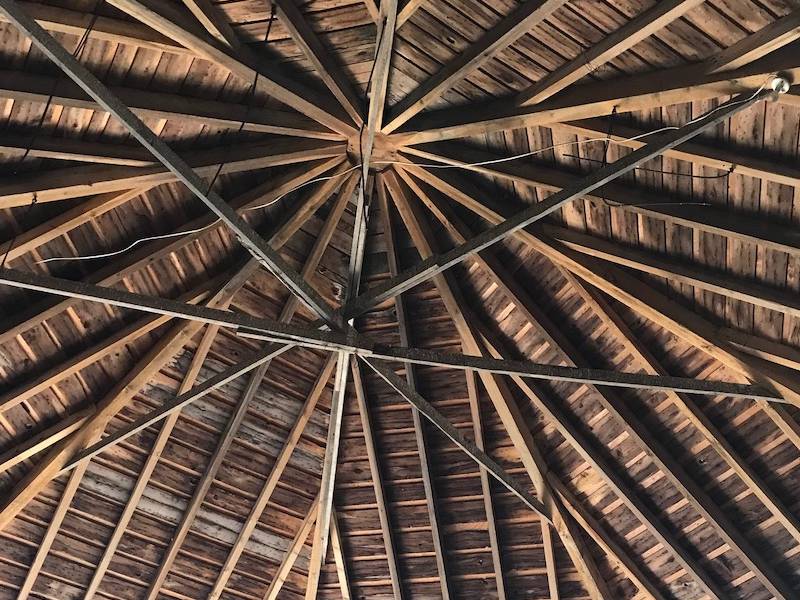
Twenty years ago, meteoric growth gripped McHenry County before a tightening economy and the pandemic intervened. While growth can be a very good thing for jobs and tax revenue, it also can pose a significant threat to local historical landmarks.
Sometimes, at rare times, there is a synergy between the past and present. True North Properties plans to convert an 1888 former village hall and senior center in Cary into 10 apartments. It did something similar with the Immanuel Lutheran School property in Crystal Lake and is in the midst of turning a former Cornell Brothers milk condensing factory in Huntley into 37 apartments.
In all of these cases, the exterior will remain largely intact. But what about on the inside?
The exterior of the 1876 octagonal horse barn near Spring Grove is not all that impressive. But step inside and look up, and the ceiling appears almost cathedral-like. And it might well be the only remaining octagonal barn left in the county … at least for the time being. Jack Pease, president of McHenry-based Super Aggregates Inc., recently bought the remainder of the former Fred Hatch farm (site of the now-demolished first silo built in this country). Pease said he intends to mine the estimated 100 acres on the north side of Main Street and develop the current Kattner farmstead to the south.
“We want to take that 23 acres and subdivide it into four, 5-acre home sites,” Pease said. “None of those buildings there [now] would really be in tune with that. It’s not in tune with me leaving one building where homes would go. I paid too much for the property.”
Pease would like to annex the property to the village of Spring Grove, although village Building and Zoning Officer Bob Walczak confirmed that no paperwork has been submitted to date for the property.
Gene Kattner said his family has lived on the property at 801 Main St. since 1921, originally part of a 230-acre farm that focused on raising corn, dairy cows and some beef cattle. Fifteen years ago, the family sold 115 acres along the Nippersink Creek to the McHenry County Conservation District.
The 1876 barn, which once housed horses on its lower level, purportedly has beams repurposed from Bliven’s Mill. One wall is open, but the roof, reinforced in 1986, looks solid. There also is a beautiful 1957 rainbow truss barn on the property. Destroyed by fire Jan. 31, 1957, Kattner said, local farmers gathered and raised the current barn in two months.
The Kattners will continue to farm the property through this year. Pease expects it will take about a year before work begins on the residential lots and the barn will come down … unless someone wishes to move it. Pease said he would be willing to give it away in order to preserve the octagonal barn.
“I’d love nothing better than to drive 5 miles away and say, ‘Hey, they reconstructed the barn over here,’ ” Pease said. “We would, at a minimum, sell the timbers so that they would end up in someone’s recreation room.”
I would like to think we could do better than carving it up into fireplace mantles.
• • •
I initially was excited to read that the village of Antioch had made a significant commitment to restore murals in its downtown. The Village Board approved “Ghosted: Bringing History to Downtown Antioch” in July as part of an overall branding strategy. It is paying Right Way Signs of Chicago $26,200 to paint five murals, with research assistance from the Lakes Region Historical Society.
Researcher Ainsley Wonderling said the Gambles Hardware is the only wall sign being restored as is. Others are being tweaked or relocated at the behest of business owners or the village. An Antioch sign mimicking a Curt Teich postcard, as well as signs for Gold Medal Flour, Scott’s Dairy and Reeves Drug Store – which was changed to “prescriptions” – were subject to a “poetic license” that included different colors and designs, Wonderling said.
The political push and pull surrounding this downtown restoration project underscores the debate over what constitutes history. An homage to our past for no other purpose than to create a throwback feel is far different than actually restoring the genuine item. Never confuse marketing with historic preservation.
• • •
The McHenry County Historical Society and Museum is marking the final year of its featured exhibit, “Art of the Past: Discovering History through McHenry County Artists,” with a juried art show titled “This Place Matters: Historic Structures and Landscapes of McHenry County.”
Artists used their creativity and ingenuity to paint or draw historically significant buildings, structures and landscapes in McHenry County. The McHenry County Historical Society’s goal was to foster an appreciation for history and create an awareness to preserve these historic structures for future generations.
The online auction runs through Cider Fest, which is from 10 a.m. to 4 p.m. Sunday, Oct. 2, at the McHenry County Historical Museum, 6422 Main St. in Union. Half of the proceeds from the painting will be paid to the artist, with the remaining half benefiting the McHenry County Historical Society, a 501(c)(3) nonprofit organization.
• Kurt Begalka, former administrator of the McHenry County Historical Society and Museum.